The Kentucky Derby That Sparked a Lifelong Love

This story appears in the Dec. 31, 2018, issue of Sports Illustrated. For more great storytelling and in-depth analysis, subscribe to the magazine—and get up to 94% off the cover price. Click here for more.
In late April of 1958, two months after my 17th birthday, I was sitting on the back porch of our home in Skokie, Ill., when I heard the telephone ringing in the living room and then my mother's sunlit Irish lilt.
"Oh, hi, Ed," she said. I knew at once who it was. There was only one Ed who ever called—and not very often. Curious, I closed my book and listened in the hollow of the silence that ensued, until she finally said, now quietly, almost inaudibly, "Oh, my.... That sounds wonderful! What fun! He's in school, but I suppose they'd let him go a day or two for that.... Yeah, he's sitting right here. Let me get him."
She peered through the screen of the porch. I could see her ivory smile through the dusty mesh. "Your uncle Ed wants to talk to you," she said.
"Why?" I asked, stepping through the door. Edward Feeney was my mother's brother, and for the last 20 years he'd been a sports photographer for the Chicago Tribune. Over the years I had seen his many Tribune photos of the Cubs and the Bears at Wrigley Field, and of the Blackhawks at Chicago Stadium. He was a star on the staff, and on spring mornings as far back as I could remember, every first Wednesday or Thursday in the month of May, my mom would open the Tribune to the front page of the sports section, and point with sisterly pride to the color photographs that Ed had just taken in central Kentucky—of all those pretty horses on the stud farms of the Bluegrass, of big-bellied mares with their newborn foals, of those famous stallions grazing in the lush green shag rugs of their paddocks, their coats of burnished gold and gleaming bronze shining in the late-afternoon light. All of this was to announce that the month of May was coming round the sun, and with it the first Saturday in May, the day set aside by the entire civilized world for yet another running of the Kentucky Derby.
Mom handed me the phone.
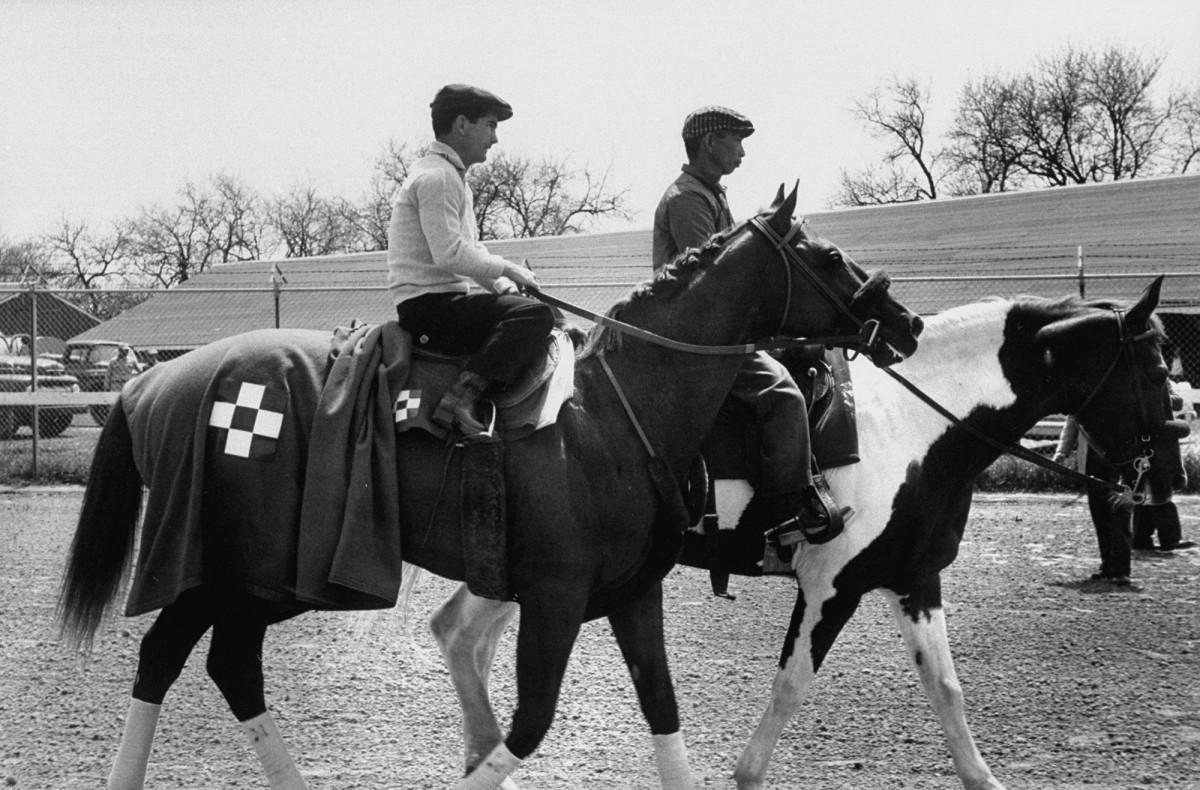
His voice was matter of fact, heard above the thumping of my heart, as clear now as then.
"Bill, Ed here. I am heading for Louisville next week to cover the Kentucky Derby, and I was wondering, with your interest in racing and horses, if you'd like to join me there on Thursday, two days before the race. We'll be staying at the Brown Hotel with the Trib columnist, Dave Condon...."
Dave Condon! I'd been reading him since I was in Little League. Kentucky Derby! Being there to see it, to witness it, was the oldest of my wishes come true.
And thus I was launched on the woolliest, most wonderful adventure of my 17-year-old life. This was my first journey alone, and I can still remember sitting on those cushioned train seats and closing my eyes, head tilted back, listening to the rhythmic clacking of steel wheels on steel rails as the City of New Orleans bore me south from cavernous Illinois Central Station. I swept through the small towns of Danville and Rantoul, past rows of silos arrayed like helmeted soldiers as far as the eye could see, south toward Louisville, the home of America's most famous bridle path—Churchill Downs—and the nation's most celebrated horse race.
Climbing off the train in Louisville's Union Station, a single satchel in hand, I sensed how a young colt must feel when turned loose to romp free and unbridled on his day of weaning. Stretching my cross-country legs—I was a sub-five-minute miler in my junior year of high school—I ran the few blocks to the Brown Hotel, dropped off my bag at the concierge desk and ran the three miles to the racetrack, whipping past the stately elms that rimmed Fourth Street and feeling those winds of youth and promise cooling my face.
Of all the adventures I had in those four days in the River City, what I remember most fondly was the morning in the barn area when I chanced to meet an immortal. Benjamin Allyn Jones was as near to a genuine thoroughbred racing legend as any man alive in 1958, the year he reached his 75th birthday. He had been retired since 1954, when he turned over his training job to his loquacious son, H.A. (Jimmy) Jones, but old Ben looked as vibrant as ever when I saw him that Friday morning, the day before the Derby, sitting as if enthroned aboard the raw-boned stable pony he had been riding for years around racetracks from California to Chicago to Kentucky. He was wearing his signature fedora, white with a gray band, and I recognized him instantly from a photograph I had seen on the cover of Time magazine in May 1949.
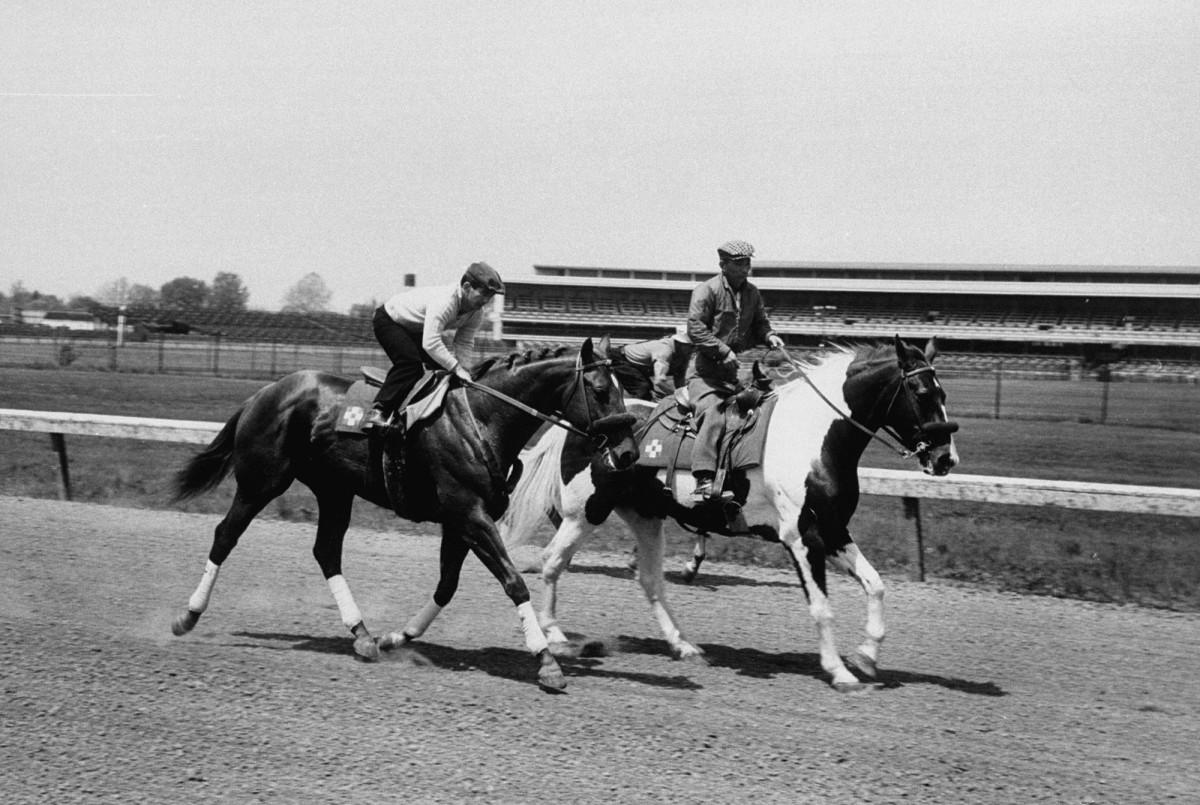
What an extraordinary life he had led since wandering away from his Missouri home to take on the world in the late 1890s. Ben had once ridden the Yucca deserts in northern Mexico with Pancho Villa, and he was known around every racetrack in America as a notorious whiskey sipper and saloon brawler who had bent the noses of scores of cowboys, cardplayers and assorted toughs from Tijuana to Miami to New York City.
Ben had bred and trained horses at his family's ranch in Parnell, Mo., and his success in that enterprise attracted the attention of the owner of Woolford Farm, in eastern Kansas. Herbert Woolf desperately wanted to win the Kentucky Derby, and he hired Ben to get him there. It did not take long for the master horseman to score in what was America's most famous horse race. Woolf named one of his homebreds Lawrin, a colt of undistinguished bloodlines, with not a gene that gave a hint of Derby quality. But Ben didn't just get Woolf to Churchill Downs on Derby day, he won the roses handily. Woolf was ecstatic. One of the witnesses to that Derby was Warren Wright, the bespectacled owner of the Calumet Baking Powder Company, and he wanted to win a Derby even more than Woolf did—to see his silks, the devil's red and blue, sweep to victory. So he stole Ben from Woolford and gave him a pot of money to train the homebred horses he was raising at his picturesque Kentucky bluegrass spread known as Calumet Farm, with its red and blue barns and acres of white wooden fences.
Over the next 15 years, Ben Jones lifted Calumet Farm onto his broad shoulders and turned it into a force in racing quite as feared and mighty as the Yankees were in baseball. In 1941 he trained Whirlaway to win the Triple Crown, and seven years later he trained the great Citation to win the Crown too. In all, he had five Kentucky Derby winners after Lawrin. I had spent many nights in the 1950s reading stories about the Calumet immortals, all those fast colts—Armed and Pensive, Ponder and Coaltown, Hill Gail and Faultless, Iron Liege and Gen. Duke—and all those nimble-footed Calumet fillies whose speed on the racetrack, and whose bloodlines at the Calumet stud, were the engines that would sustain a run of thoroughbred excellence unparalleled in the sport's long history. I could close my eyes, even then, and recall the magical names of those fillies who tore up racetracks across the land: Twilight Tear, Bewitch, Wistful, Two Lea, Princess Turia.
Ben had touched them all. And now here he was, aboard that pony, staring down at a lovely bay colt who was chomping tufts of clover and grass on the Churchill backstretch. Screwing up my courage, I approached the old man. He spotted me and nodded. I nodded back.
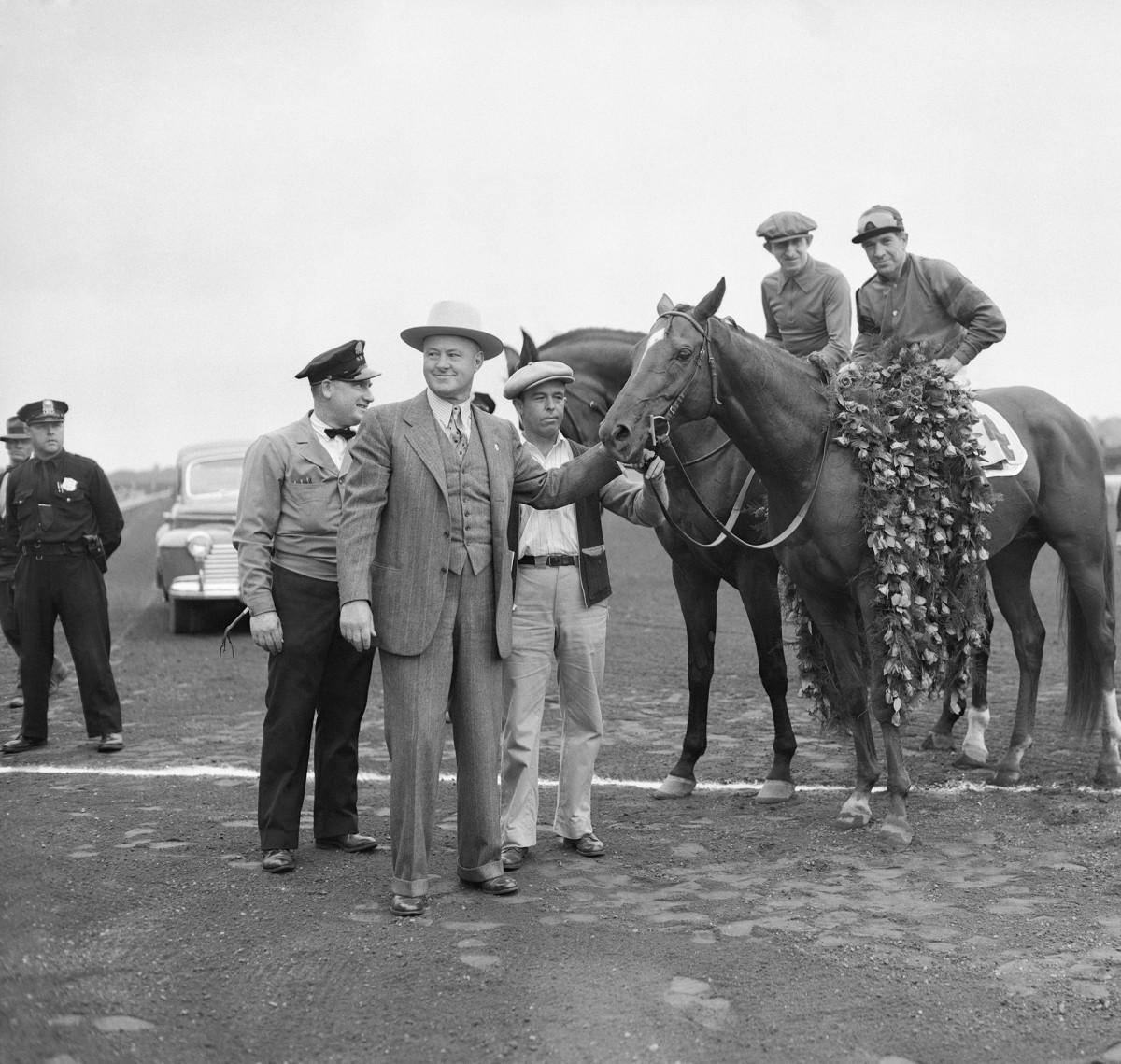
"Hello, Mister Jones," I said. "I saw you at Arlington Park last summer. You were in the paddock with Bardstown...."
Ben nodded in remembrance. "I love racing and I ride horses and I study racing history a lot and...." I hesitated, almost out of breath, and then said, "And I was wondering, of all the great Calumet horses you trained, who was the greatest of all?" One hand shielding my eyes, I squinted up at him into the morning sun.
"Armed!" he said.
I was stunned. He had trained two Triple Crown winners, Whirlaway and Citation, and more Derby winners than that, and he was telling me that Armed, a gelding, a horse castrated when he was young and unruly, was the best? Armed was a soldier of the sport, a wonderful racehorse, America's Horse of the Year in 1947, but Citation was regarded as one of the five greatest horses ever bred in America, a giant in the sport, and I could barely suppress my surprise.
"What about Citation?" I said.
"Armed could do anything," Ben said. "He could sprint, run a route and carry weight doin' it. Could do it all."
Looking for something to keep the moment breathing, I asked, "Who was his dam?"
The question gave him pause. Finally he said, "Armful."
"And who was she by?" I asked.
"She was by Chance Shot, who won the Belmont a way back. A stout pedigree."
I looked at that bay nibbling at a patch of lawn nearby, raising the scent of newly mown grass. "Who is that horse?" I asked.
"Gen. Duke," said Ben.
"That's Gen. Duke?" I blurted. He was the fastest 3-year-old in America coming into last year's Kentucky Derby, the conqueror of Bold Ruler in the fastest Florida Derby ever run.
"Would have won the Derby last year, but he got hurt," Ben said. "Maybe been one of the best ever."
"Can I?" I asked.
"Horace, let the boy pet that colt."
I stepped forward, into Gen. Duke's shadow, and touched the supple muscles of his neck, stroking his brown sleekness, almost a caress, until the colt raised his head and peered at me as if to inquire who I might be to invade his space on this spring morning.
"Thank you, Mister Jones," I said. "Good luck with Tim Tam tomorrow."
Tim Tam was Calumet's Kentucky Derby hope in 1958, a beautifully bred bay colt sired by the great Tom Fool out of Two Lea.
"Thank you, son. They all need a little luck."
I left Ben Jones and Gen. Duke in a kind of blissful daze. I had already touched the coat of one of the fastest horses in the land and talked to the greatest horse trainer in the history of the American turf.
And the clock had yet to strike noon.
I was at the very epicenter of the racing world, trailing Dave and Ed as they made the rounds on what was known among the writers and columnists as "the Dawn Patrol," the herd of scribes who show up before breakfast, often slightly hungover, and meander from one barn of Derby hopefuls to the next, chatting it up with trainers, owners and grooms—the racetrack swipes who rub and curry their beloved horses in the mornings and feed and water them in the afternoon, with old hats banged down on their graying heads, rub rags hanging from their back pockets and strings of steel safety pins dangling from their trousers. The pins needed to be within reach as they kneeled and wrapped protective bandages round their horses' delicate, valuable legs.
Even today, all these years later, I can still see Ed shooting pictures of Gone Fishin', a little gray colt, and his trainer, Charlie Whittingham, as Charlie led the colt through the gap in the fence toward the racetrack for his morning constitutional.
"Can you hold him there for a second?" Ed yelled.
Charlie stopped the colt, who gazed, ears pricked, towards the ascendant spires rising above the Downs.
Ed clicked the shutter. "Thank you," Ed cried. The gray moved on.
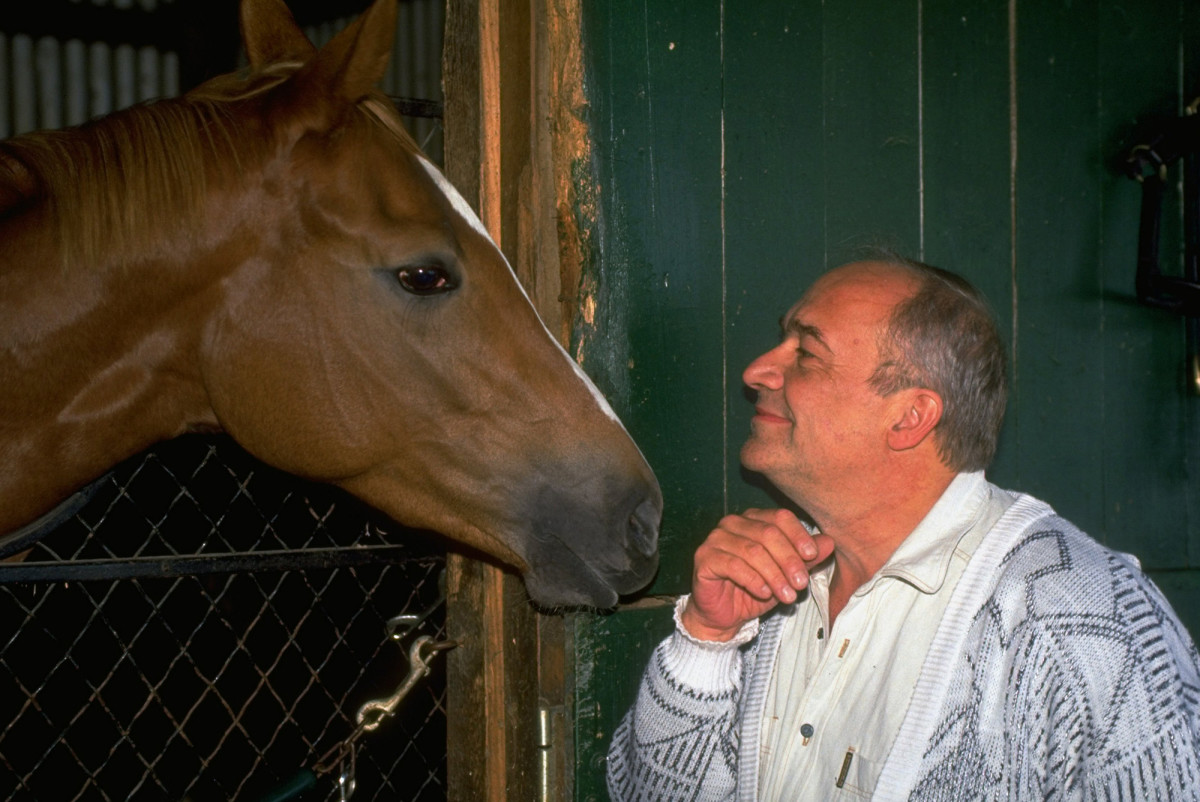
I can still see the writers gathered around that coppery bright chestnut, Silky Sullivan, already a stretch-running immortal, as his groom gave him a sudsy, warm bath on the patch of grass outside his barn. Can still see Condon scribbling in his little spiral notebook as he interviewed Ben Jones's son, Jimmy, the trainer of Tim Tam, who was circling a cinder trail outside his shed following a strong morning gallop. The sun was up and counting change at her old lemonade stand in the sky, and a thin patina of sweat made Tim Tam's chocolate coat glisten in the tree-sifted light. He was coming to the race beautifully, his eyes afire, as though lit by a Bedouin torch passed down through generations, from the windswept deserts of Arabia to the ancient rolling leas of England and Kentucky.
By early afternoon I was back in our room at the Brown and sitting on the end of my cot and watching Condon, stripped down to his T-shirt and boxer shorts, as he pulled up a chair by the open window—no air-conditioning in those days—and began tapping out his Tribune column for the next day. He lit one unfiltered Camel cigarette after another, igniting a new one off the old, now staring out the window at the warm spring day, now pounding furiously on his portable Smith-Corona, now taking a drag from his cigarette and then staring again and muttering words to himself as he typed what he had seen that morning: "The Calumet horses came away from their barn in single file, riders up, moving as majestically as cavalry to their morning workouts."
Seeing Dave tear out page after page of copy from his typewriter, I was suddenly struck by the quite romantic notion that writing about this sport—about this isolated island world, the nobility of these animals, about the way Ben Jones wore his fedora and growled his words and sat straight as a ramrod on his pony—might be a pleasant way to make a living up the road. As Dave finished his column, he handed me the sheaf of papers and said, "Bill, take these down to Western Union in the lobby. He'll know what to do." So I bore them down the five floors to where the Western Union man sat in his room, a cigar between his teeth, and typed the story into his machine. Next morning, of course, I was the first one in the lobby to catch the bundle of papers as the delivery boy threw them from the truck. I tore open the Trib to the sports section, and there it was, IN THE WAKE OF THE NEWS, by David Condon. And there was the story, just as I had seen him write it, just as I had run it down the stairs, complete with that lead sentence about the Calumet horses moving majestically, in single file, to the track.

I felt, for an instant, like a courier of history, a part of the drama, a minor figure in the biggest of all American shows.
At 3:45 p.m. on Saturday, toting a bag of Ed's cameras and film, I toed my way cautiously along wooden planks laid across the muddy track. Ed set one camera under the rail, shooting up at the finish, while I watched this truly delicious scene as it unfolded before me. In my larval stages of studying the American turf, I had come across a fanciful line from the noted journalist Irvin Cobb, who said:
"Until you go to Kentucky and with your own eyes behold the Derby, you ain't never been nowheres and you ain't never seen nothin'!!"
It was at that sublime instant, as the horses came out on the track to begin the post parade, with those jockey silks shining and the band striking up "My Old Kentucky Home," that I began to divine what Cobb meant almost 50 years before. The whole joint rose as one, 100,000 voices strong, to sing Stephen Foster's melancholy anthem of the past. From across the track, as Ed and I stood by the finish line pole, I could see an array of brightly colored Southern belles wiping tears from their eyes as that song echoed from the cavernous stands:
Weep no more, my lady,
Oh! weep no more today!
We will sing one song
For my old Kentucky Home,
For the old Kentucky Home, far away.
At precisely 4:32 p.m., the 14 Derby horses lunged from the starting gate. A roar went up as the battle began. Just 23 1/5 seconds later, sounding like a troop of cavalry moving at attack speed, they all came racing past me just 15 feet away. A whippet-quick little bay named Lincoln Road was leading into the first turn, with Tim Tam, jockey Ismael Valenzuela up, slogging along in the mud in the middle of the pack. Far behind them, in a fleeting gust of glory, came Silky Sullivan, by then already so far behind that he galloped past us all alone, Bill Shoemaker rocking on his back.
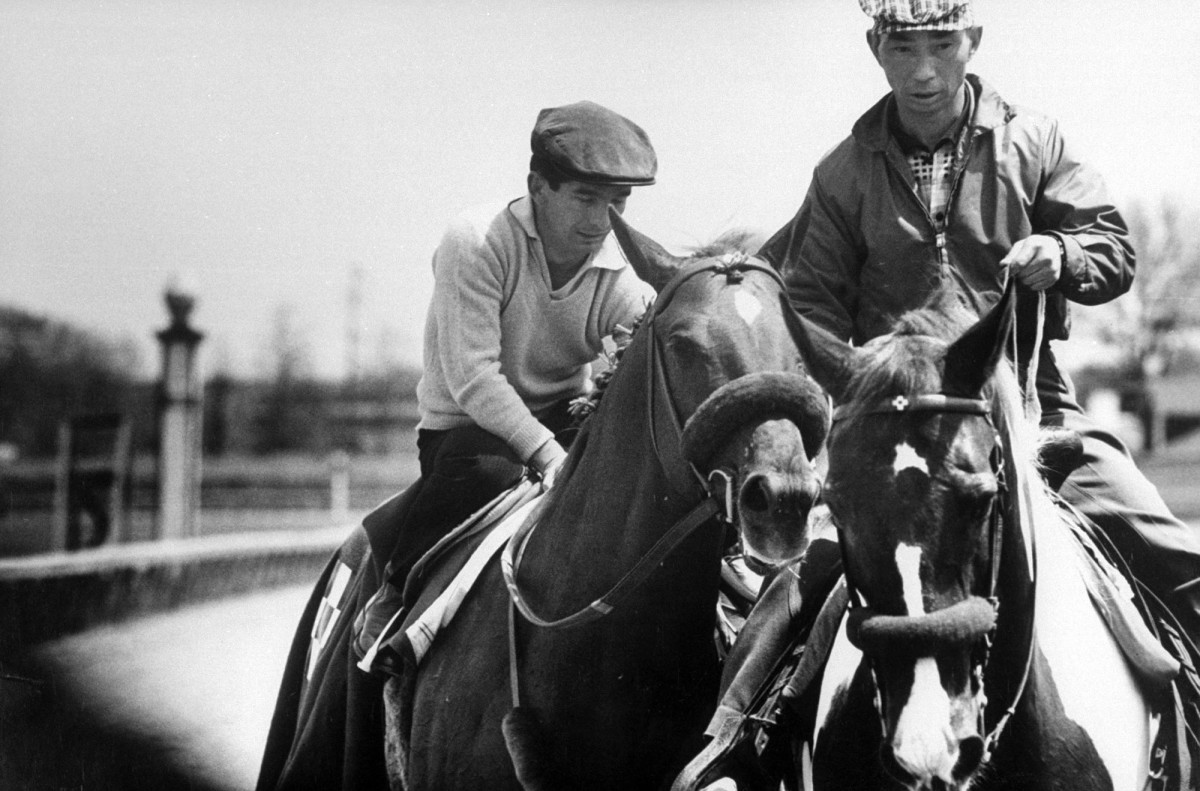
Ed was snapping pictures feverishly, unloading used film and replacing it with new. I stood agape, my eyes bugging from my head. Ed was as cool as an old salt on the high seas during a storm. "Hand me that packet of film," he said calmly. I reached it towards him. He slipped it into one camera, then two, and backed up and waited for the horses to turn for home. Ninety seconds later the din at Churchill Downs grew thunderous, with the crowd roaring even louder now, raucous and full-throated, and for a moment it looked like little Lincoln Road was going to win it all. He was still leading the field after a mile on the turn for home and through that long Churchill stretch. Now, with just 100 yards to go, Lincoln Road was in a desperate, pitched struggle to win this Derby when Tim Tam, Milo whipping and driving him, descended like pharaoh's ghost on the outside.
I held my breath as Lincoln Road dug in.
I saw those famous silks, the devil's red and blue, bearing down on him. In the last few jumps, Tim Tam surged past Lincoln Road to win this Derby by half a length. The scene near that finish pole unfolded in jubilant chaos. Calumet grooms and stable workers appeared out of every corner of the Downs, screaming and waving their hats in the air. Moments later, to gusting cheers, Ben and Jimmy Jones were leading a hot and muddy Tim Tam past me to the charmed circle while jockey Valenzuela, wiping the earth from his face, beamed at the crowd.
This was the single most colossal experience of my youth, the seminal event in defining my journalistic life. Some four years later I enrolled in the journalism school at Illinois, and nine years after that I was plodding along as a political writer at Newsday, on Long Island, when my life turned on a miracle of perfect timing. Many years before, after the winner of the 1955 Kentucky Derby, a colt named Swaps, dropped his head over the railing at old Washington Park and breathed on the back of my hand—thus infusing me with a love of that game and those horses that would own me forever—I sat in my bedroom at home and memorized all the Derby winners from 1875, when little Aristides won the inaugural running, right up to Swaps in 1955.
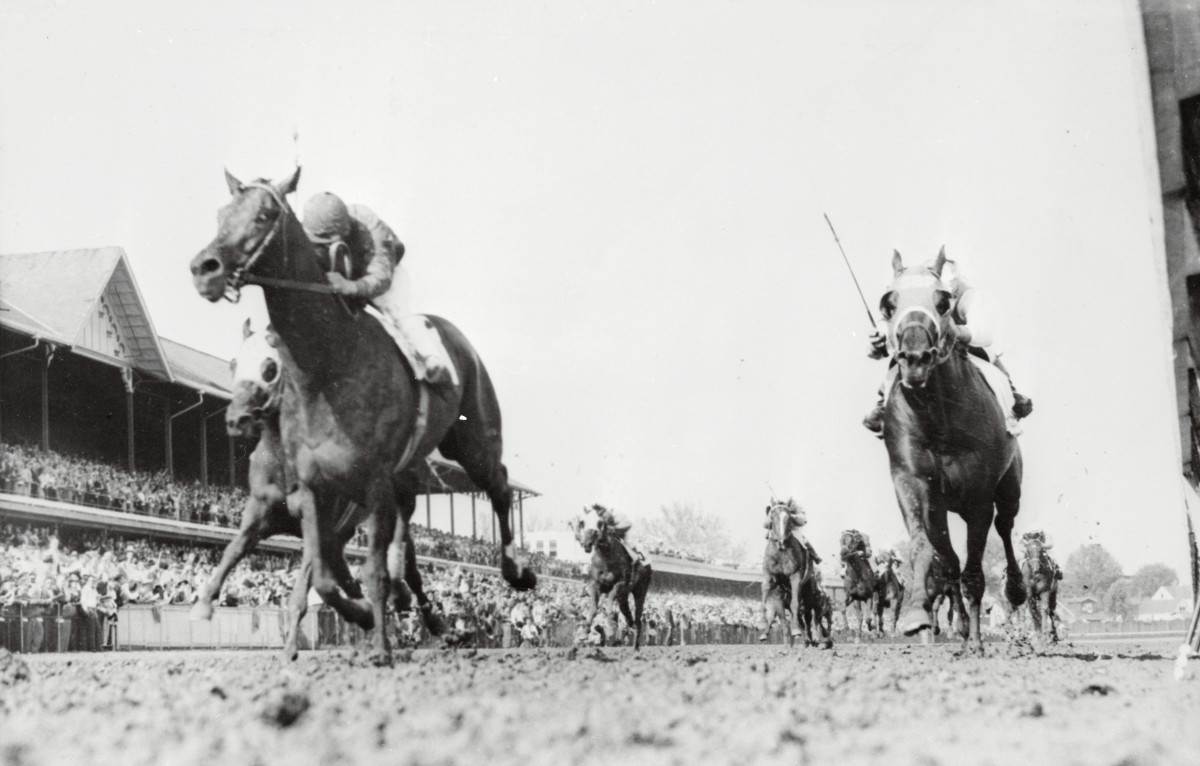
I guess this was my way, now that I think about it, of returning his memorably warm breath with my even warmer affections.
In December 1971, memorizing those Derby winners, and those that followed, no doubt saved me from fates even worse than covering the White House. At the annual bourbon-laced, eggnog-inspired Christmas party at Newsday, at the urging of friends who knew of my love of racing, I climbed on the desk in the middle of the city room and recited all those winners once again; as I dismounted that table to cheers, the editor of the paper, David Laventhol, came by and whispered, "Why do you know that?"
I told him my whole story—about hanging out at racetracks since I was a kid, about the photo of Swaps I carried in my wallet, and about my trip 13 years earlier to the '58 Derby. I told him how I had rubbed horses at old Arlington Park, taught riding when I was a kid and how my life had been one long embrace of that magnificent species, the running horse. Five minutes later Laventhol decreed that I would be Newsday's new thoroughbred racing writer. So David, in an act of mercy, made my hobby my job. Three months later, in April 1972, I was trooping into Belmont Park with a spiral notebook in my hand to cover the sport, and a month after that, an old exercise rider named Jimmy Gaffney introduced me to an unraced, unknown two-year-old who answered to the name of Secretariat.
Through a book I wrote about Secretariat and his quest to win the 1973 Triple Crown, and a Disney movie based upon that book, I have been riding that magnificent beast ever since.
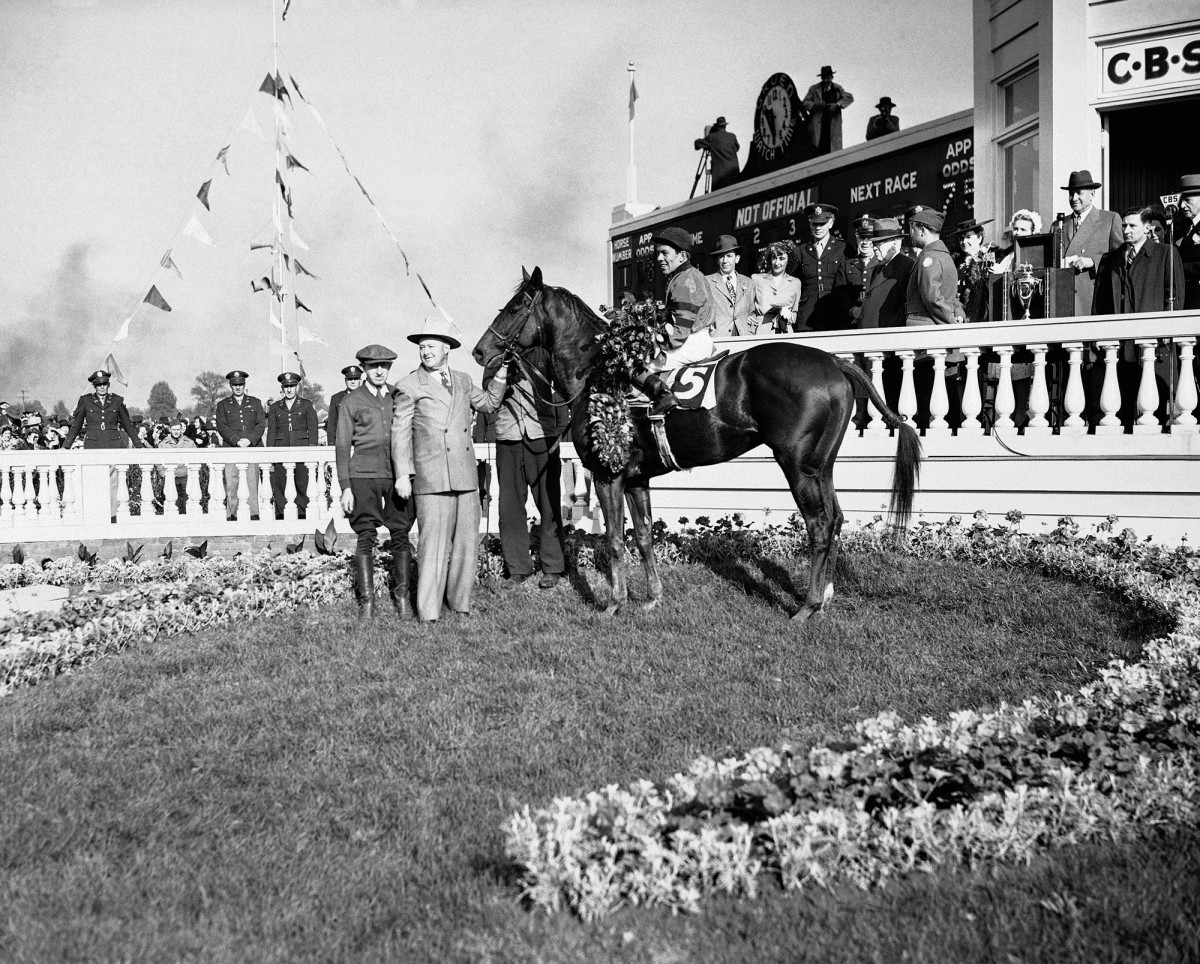
Fifty years after I stood by that same finish line with Ed in 1958—in fact, 50 years later to the day, May 3, even to the hour, 6 p.m.—I was standing there yet again for the 2008 Derby, this time working for Blood-Horse magazine. One of the Blood-Horse editors had asked me to come to the Derby to relive the experience I'd had at 17. As I leaned on the fence by the finish line, bracing myself in the gusting 25 miles per hour winds and even harder into the howling winds of history, I could hear the track announcer's distant voice intoning, "They're all in."
At once there came this comber of sound rolling across the Downs as 157,770 souls—the second-largest crowd ever to witness the Derby at the time—cheered loudly as the horses vaulted from the gate. For a moment, as the field of 20 came charging past me, it was like an old dream come alive again, a familiar scene in Technicolor replay, with the whole of those sights and sounds coalescing in a remembrance of things past, a vision in the rearview mirror, clear and true.
There before me rose the mammoth clubhouse and grandstand at Churchill, looking like a giant ocean liner marooned on a Kentucky moraine, with the twin spires rising as smokestacks, its five decks acrawl with people. There before me came those 20 horses, plunging forward as their ancestors had five decades before. And there before me, rising like so many ghosts, came all those memories stained and colored by 50 years of time. A horse named Big Brown won that race, running well within himself as he came home, his left eye gleaming as he ran by me at the wire, enjoying a much easier time of it than Tim Tam had in '58.
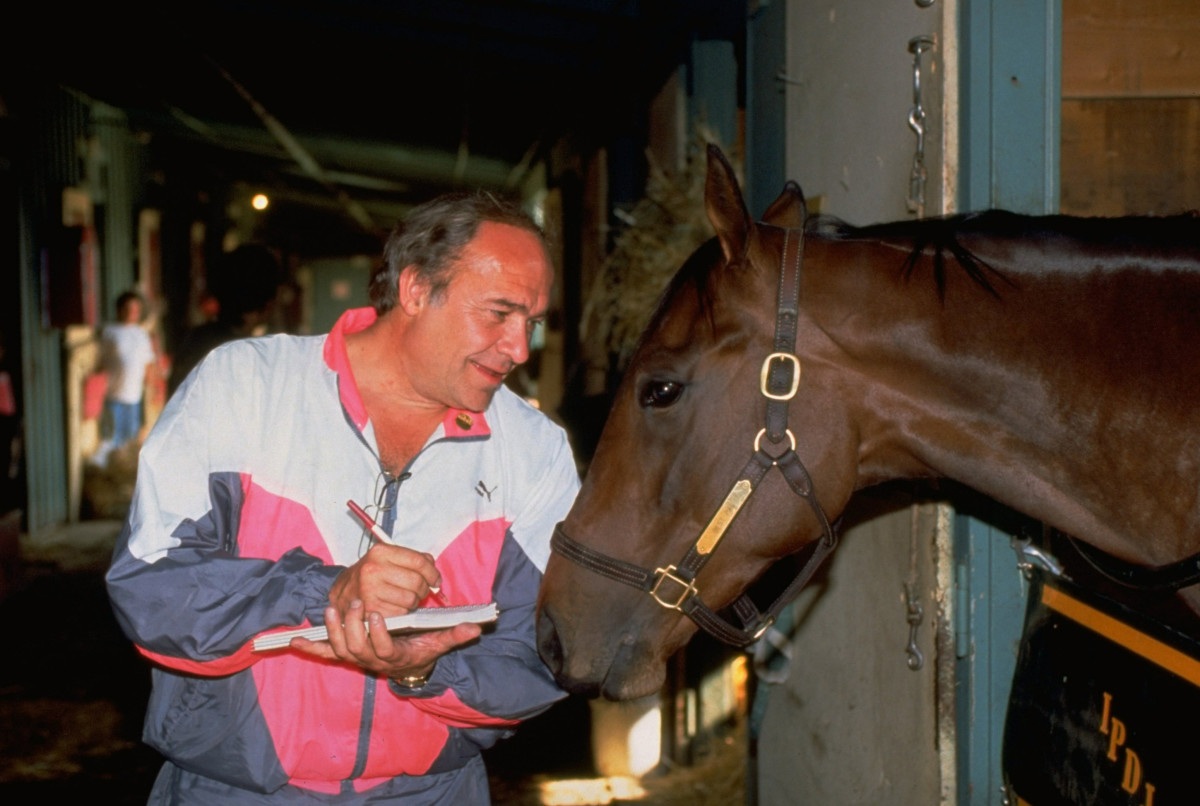
Alas, all of them from those good old days are turned to fading shadows now and gone—Ed and Dave, Mom and Dad, Ben and Jimmy, Tim Tam and Gen. Duke, Charlie and the Shoe, Lincoln Road and Silky Sullivan, all those pretty horses.
Long gone, so long.
All these years later, I can still see them all. And I cannot shake, not in my dreams, not in my sleepless hammock reveries, that haunting line from William Faulkner set to the poignant rhythms of his poetry: "The past is never dead. It's not even past."
